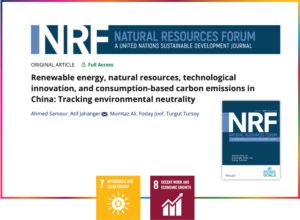
A collaborative research effort, featuring co-authors Ali, Joof, Tursoy from Near East University, delves into an often-overlooked aspect of environmental impact – consumption-based carbon dioxide emissions (CCO2) in China. The study spans the years 1990 to 2019, employing the sophisticated “bootstrap autoregressive distributed lag (BARDL)” approach to scrutinize the influence of technological innovation, renewable energy, natural resources, and the banking sector on CCO2 emissions.
The key findings of the research highlight several critical insights. Firstly, economic growth and natural resource utilization negatively impact environmental neutrality, emphasizing the need for strategic measures. Secondly, the study underscores the pivotal role of environment-related technologies and renewable energy in promoting environmental neutrality. Surprisingly, the banking sector in China is found to have a positive association with CCO2 emissions, signaling the need for more environmentally conscious banking practices.
The study’s recommendations emphasize the implementation of effective measures to combat ecological pollution. Prioritizing green energy sources and fortifying the banking sector through environment-friendly investment loans are proposed as crucial steps. Additionally, strategies should be designed to reinforce sustainable development practices in China.
In-depth analysis reveals a long-run equilibrium association among the variables under consideration. Natural resources and economic growth exhibit a positive association with CCO2 emissions, while renewable energy and technological innovation display a negative linkage. Short-run findings corroborate these associations, solidifying the impact of these factors on environmental neutrality.
Causality tests further unveil the interconnectedness of renewable energy, economic growth, natural resources, banking development, technological innovation, and CCO2 emissions in both the long and short run. Notably, the study’s main revelation is the positive linkage between banking development and CCO2 emissions in the case of China. This finding underscores the necessity for stringent environmental regulations within the banking sector to prevent unintended consequences on ecological pollution.
In conclusion, this collaborative research provides valuable insights into the intricate dynamics of factors influencing CCO2 emissions in China. The nuanced understanding gained from this study paves the way for informed policy decisions, emphasizing the importance of sustainable practices in technological innovation, renewable energy, and banking sectors for a greener future.
More Information:
https://onlinelibrary.wiley.com/doi/full/10.1111/1477-8947.12327